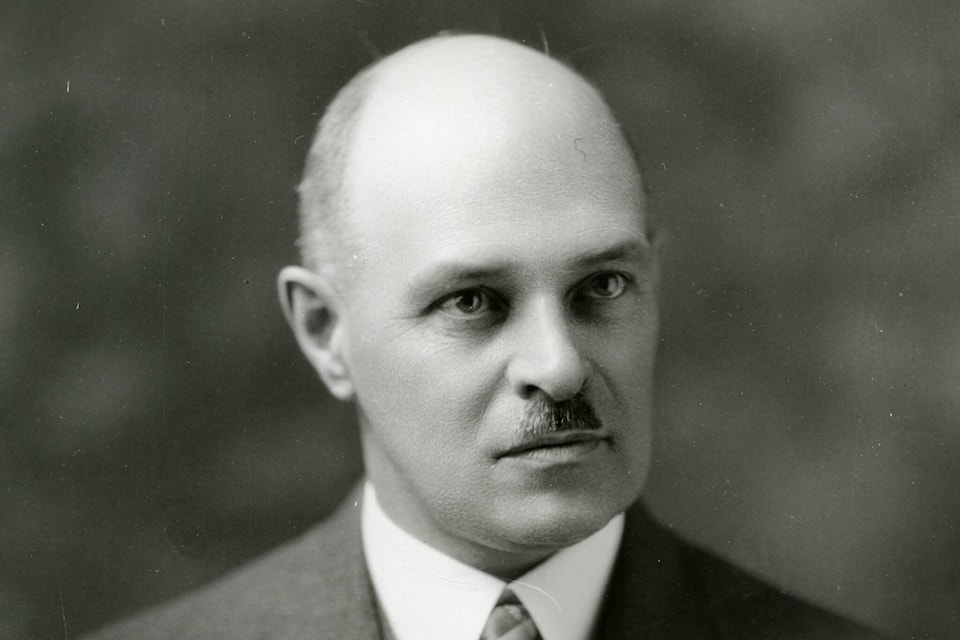One of the most prominent early residents of Red Deer and a man who served as Red Deer’s city solicitor for 36 years was William Ernest Payne.
W.E. Payne was born in Colborne, Ontario, on October 1, 1878, the son of W.L. and Emma Powell Payne. His father was a very successful lawyer and Ernest grew up in well-to-do circumstances.
Ernest decided to follow his father in the practice of law and graduated from the prestigious Osgoode Hall in Toronto in 1902. Upon graduation, he decided to head west to pursue the prospects of the rapidly growing Canadian West.
He entered into partnership with George Wellington Greene, Red Deer’s first lawyer, in the firm Greene and Payne. Their offices were in the beautiful two-storey sandstone building which Greene had built on the southwest corner of Ross Street and Gaetz Avenue. That building still stands to this day.
G.W. Greene personally had served as the town solicitor since 1901. In 1907, the position was extended to include both partners in the firm. When Greene was appointed as a district court judge in Medicine Hat in 1916, Ernest was joined in the partnership by P.E. Graham. They continued to be the city solicitors.
Meanwhile, in 1906, Ernest married Mary Forbes, a nurse who was also the niece of Rev. G.W. Kerby, the long-time principal of Mount Royal College in Calgary. The newly-weds moved into a large new home on the north side of 49 Street, east of 47 Avenue. That was to remain the family residence for all the time that the Paynes lived in Red Deer and still stands today.
The Paynes were to have four children – Forbes, Frances William and Mary.
Ernest immediately took a strong interest in local education and in 1906, was elected as a trustee on the Red Deer Public School Board. He continued to hold the position for 21 consecutive years, including 6 years as Board Chair.
Other strong community interests included the Red Deer Board of Trade which he joined in 1903 and remained an active member for many years. He was a charter member of the Red Deer Rotary Club in 1923 and served as president in 1926. He became the president of the local Young Conservatives in 1908 and later served as president of both the federal and provincial Conservative constituency associations.
Given his strong interest in politics, it is not surprising that Ernest was the provincial Conservative candidate for Red Deer in the elections of 1926 and 1930. Although he lost both of these contests, after George Wilbert Smith died in office in 1931, Ernest ran once more in the subsequent by-election. This time he was successful and served as Red Deer’s M.L.A. until 1935 when Social Credit swept to power and took the Red Deer constituency in the landslide.
Meanwhile, one of Ernest’s strongest interests was in sports. He played hockey, baseball and lacrosse as a young man. In 1903, shortly after he moved to Red Deer, he became the manager of the Red Deer Football (Soccer) Club. In 1908, he was elected president of the Red Deer Curling Club.
He joined the new Red Deer Golf Club in 1922 and helped create the new Red Deer Golf course on the northside of the Red Deer River. In 1923, he became the second president of the organization.
Ernest became very active in the push to build an arena in Red Deer in the 1920s. With the successful completion of the project, he became the first president of the non-profit arena company in 1926.
Ernest continued to be interested as well in the organization of the Law Society of Alberta. He served as a bencher for 25 years. He was elected president in 1940-1941.
Tragedy struck the family in April 1922. Ernest and Mary’s oldest son Forbes was killed in a car accident. The car, in which he was riding with other members of the high school baseball team, upset while enroute to a game in Penhold.
Ernest Payne passed away in April 1943 of a severe heart attack. His wife Mary then moved to Edmonton to live with their eldest daughter Frances.
There is a beautiful stained glass window in Gaetz Memorial United Church in memory of W.E. Payne. Payne Close in the Pines subdivision in named in honour of the family.
Michael Dawe is a Red Deer historian and his column appears on Wednesdays.
